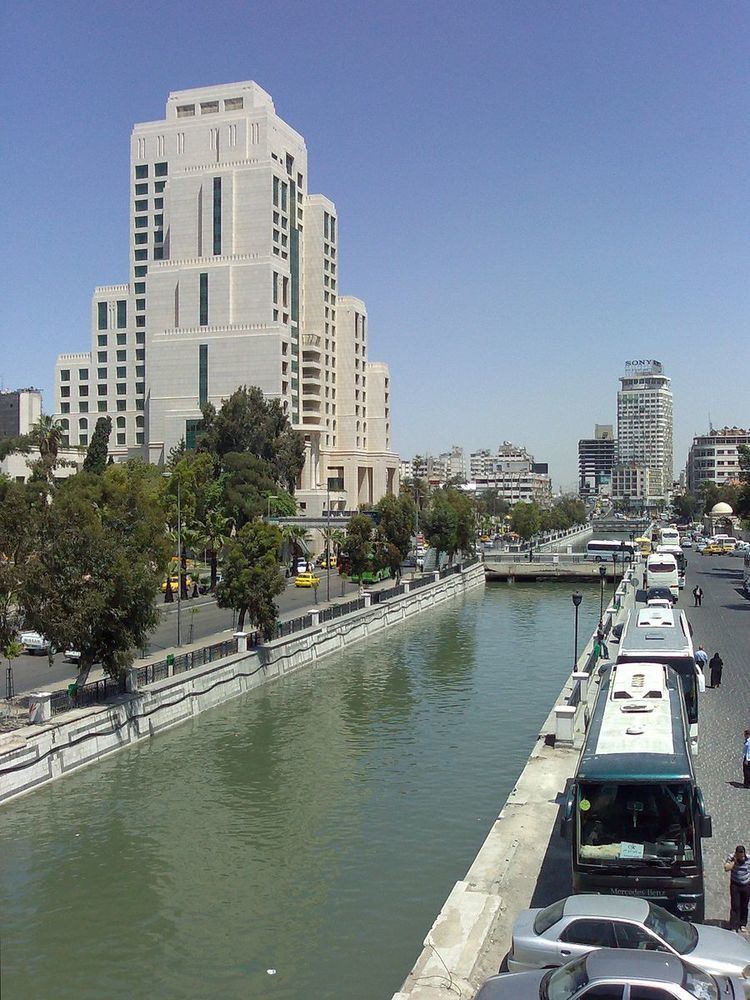 | ||
Water resources management in Syria is confronted with numerous challenges. First, all of the country's major rivers are shared with neighboring countries, and Syria depends to a large extent on the inflow of water from Turkey through the Euphrates and its tributaries. Second, high population growth and urbanisation increase the pressure on water resources, resulting in localized groundwater depletion and pollution, for example in the Ghouta near Damascus. Third, there is no legal framework for integrated water resources management. Finally, the institutions in charge of water resources management are weak, being both highly centralized and fragmented between sectors, and they often lack the power to enforce regulations. Water resources policies have been focused on the construction of dams, the development of irrigated agriculture and occasional interbasin transfers, such as a pipeline to supply drinking water to Aleppo from the Euphrates. There are 165 dams in Syria with a total storage capacity of 19.6 km³. Demand management through metering, higher tariffs, more efficient irrigation technologies and the reduction of non-revenue water in drinking water supply has received less emphasis than supply management. The government implements a large program for the construction of wastewater treatment plants including the use of reclaimed water for irrigation.
Contents
Water use
Total annual water withdrawal was estimated at 19.4 km³/year in 2008-2009, including 2.4 km³/year taken by depleting groundwater and surface water reservoirs. It was estimated at 16.7 km³/year in 2003, 88% of which was for agricultural purposes.
Overexploitation of groundwater
In some basins, such as that of the Barada around Damascus, total water use exceeds availability of renewable water resources, resulting in overexploitation of groundwater. In the Mleita plain around the town of Al-Nabk in the Kalamoon Mountains north of Damascus, for example, the water table declined from 35 meter in 1984 to below 250 meter in 2009. Agriculture all but disappeared and the fertile valley was turned into a dusty wasteland. Other areas of heavy groundwater overxploitation are the area around Mhardeh in Hama Governorate, Khan Shaykhun in Idlib Governorate and the Damascus Ghouta where groundwater levels dropped by more than 6 meters per year in some areas between 1993 and 2000. Overexploitation of groundwater has contributed to a decline in the flow of the Khabur River which has ceased to flow during summer since 1999. The number of wells in Syria has been estimated to have increased from 135,089 in 1999 to over 213,335 in 2007, according to the National Agricultural Policy Centre (NAPC). The lands irrigated by groundwater increased from 652,000ha in 1985 to 1.4m ha in 2005. Rural electrification, diesel subsidies and subsidized loans for the drilling and equipment of wells contributed to the boom in groundwater irrigation.
Water pollution
According to the Syrian National Environmental Action Plan of 2003, surface and groundwater are contaminated in many areas with domestic and industrial wastewater. For example, in the Barada River concentrations of biological oxygen demand (BOD) and ammonia exceeded Syrian Standards for 86% of collected samples between 1995 and 2000. Well and spring water in the basin is bacteriologically contaminated because of sewage discharge. The concentrations of nitrates in some wells in the Ghouta near Damascus exceeded the limits set by the drinking water standards. Because of discharges by tanneries concentrations of Chromium III reach 10 mg/liter in Al Daiyani River and exceed the allowable limits ten-fold in the wells of Al Zablatini area, all located in the Barada basin.
On the Orontes River analyses of water samples for ammonia, suspended solids and BOD indicated that concentrations exceeded the allowable limits, particularly in the lower part of the river. In the upper part, water quality is acceptable. On the Quweiq River flowing through Aleppo concentrations of BOD, ammonia and heavy metals exceeded allowable limits. In the coastal region wells used for drinking purposes are contaminated with high concentrations of nitrates and ammonia because of sewage discharge and use of fertilizers. Water salinity is also high in some wells because of seawater intrusion into the fresh groundwater aquifers.
Dams
There are 165 dams in Syria with a total storage capacity of 19.6 km³. By far the largest dam is the Tabqa Dam, located near Raqqa on the Euphrates and forming Lake Assad. Its purpose is production of hydropower, irrigation and storage of water for drinking water for Aleppo. Medium-size dams include the Al-Rastan (0.2 km³), the Lake Homs Dam (Qattinah) (0.2 km³), the Mouhardeh (0.07 km³) and the Taldo (0.02 km³). In 2007 there were 49 dams on the Orontes River with a total storage capacity of 1.5 km³, or more than three times the average annual flow of the river. There were 42 dams on the Yarmouk with a total storage capacity of 0.3 km³. Twenty-one dams are located in the coastal area with a total storage capacity of 0.6 km³.
Legal and institutional framework
A comprehensive regulatory framework for integrated water resources management does not exist in Syria. Over 140 laws dealing with water have been passed since 1924. Prohibitions on well drilling and groundwater pollution have been passed, but there are no clear mechanisms for their enforcement. The Syrian water sector is both highly centralized and fragmented between sector institutions that have overlapping functions and responsibilities. A Council of General Commission for Water Resource Management is in charge of integrating water policies between various Ministries. According to another source there is a Higher Water Committee, which is presided by the Vice Prime Minister for service affairs. According to a report on Syria's water resources, "one of the consequences of the fragmentation and lack of coordination within the water sector is that key water resource data are not exchanged between the different institutions, which in turn hampers effective policy making."
Ministries with responsibilities related to water resources management include:
